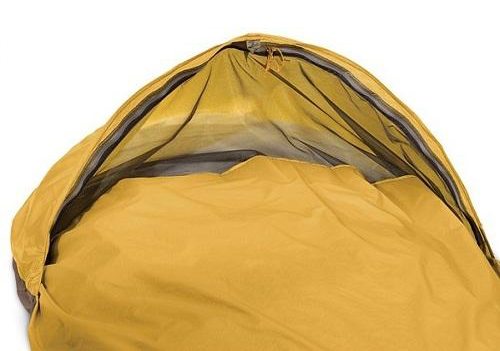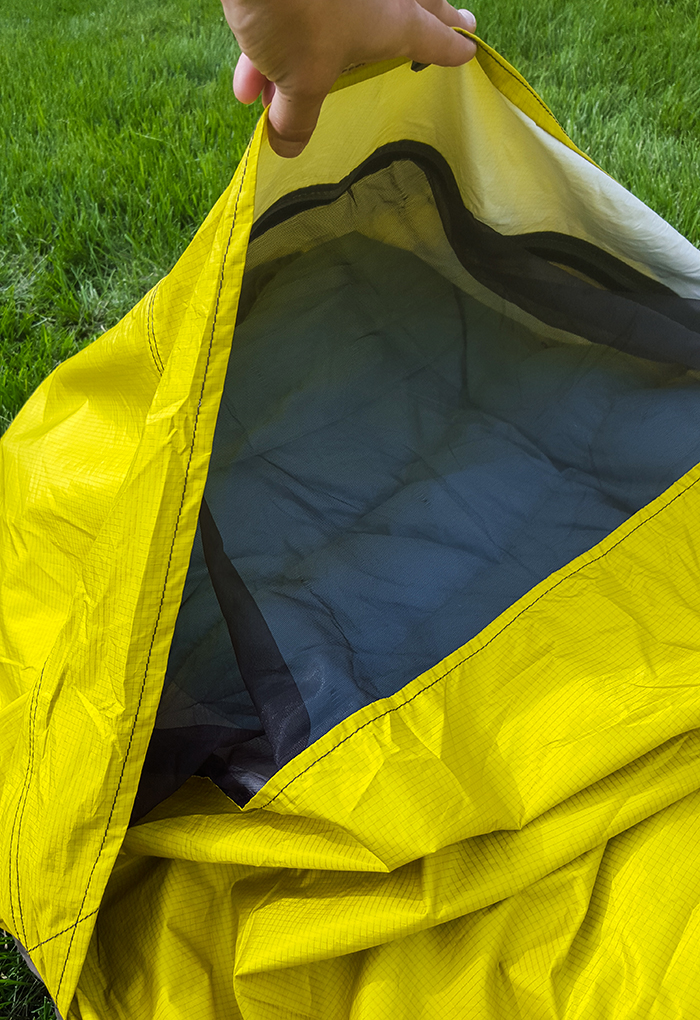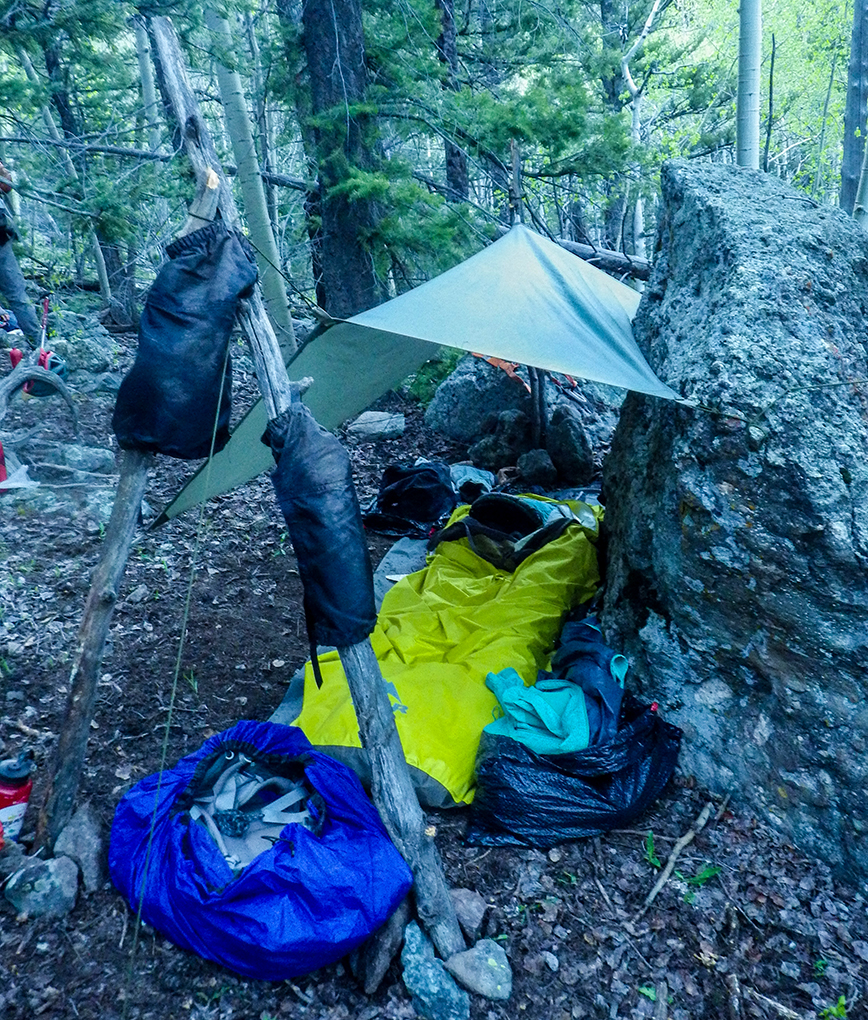
MSR AC Bivy
Size: 36” across at shoulder, 23” across at feet, 88” long
Packed Size: 4”x 8”
Stated Weight: 450 g (16 oz)
Top Material: 2-layer 40D ripstop nylon
Floor Material: 10,000mm DuraShield polyurethane & DWR coated floor, 40D ripstop nylon
Stated Features:
- Ultra lightweight (1lb)
- Extremely compact (about the size of a 1L Nalgene water bottle when packed)
- Spacious
- Mesh closure for bug protection
MSRP: $199
Reviewer: 5’8”, 123 lbs.
Duration of Test: 30+ days
Test Locations: Turtle Rock, Buena Vista, Sangre de Cristo mountain range, and Gore mountain range, Colorado
Intro
This summer season has been unusually wet in Colorado, and since I was planning to spend a significant portion of it backpacking and mountaineering, I decided to test MSR’s ultra lightweight and extremely compact AC Bivy sack to see if it would keep my down sleeping bag dry while sleeping in the elements for weeks at a time.
Size
This bivy is HUGE! Compared to many other bivys on the market, it is one of the widest at the shoulders (36”), and is only surpassed in length by the Black Diamond Big Wall Hooped Bivy, which is 99” long, but weighs twice as much as the 16oz AC Bivy.
I was able to (1) put my gear at my feet in the AC Bivy to help keep me from sliding toward the bottom, (2) lay out essential items (glasses, headlamp, watch, etc.) to the side of my head for easy access at night, and (3) lay out clothes I needed to dry overnight alongside my sleeping bag. I could sleep soundly knowing that my essentials were safe from the rain overnight.
One downside to the size of the roominess of the bivy is that I did find that my sleeping pad could slide around inside, despite the slight grippiness of the floor, which was intended to prevent this.
Overall, though, I did love that the bivy was large enough for my full sleep system + essential gear, and even had space to lay out items that needed to dry overnight, all while weighing only a pound.
Features & Design
MSR talks up the AC Bivy’s simplicity and minimalism, and with good cause. There are no extra bells or whistles, no unnecessary frills. It has no poles and only 1 zipper, so after a long day adventuring, you don’t have to set much up to get ready to sleep.
The bivy does have a mesh screen about 1/3 of the way down from the top of the bag for keeping the bugs away while you sleep. The bivy is designed so that the head portion of the top cover of the bivy has a zipper that attaches to and overlaps the mesh and body portion of the top cover.

Think of the letter “Z”: the top and bottom portions represent the waterproof ripstop nylon, and the diagonal line represents the mesh folded over in the middle.
The beauty of this design is that the mesh isn’t exposed to the outside, so rain is less likely to make it inside. However, the problem with the design is that the nylon covers the mesh screen / opening to the bivy, and breathability is therefore an issue (more on this belowf).

One gripe that I have with the AC Bivy is that while the packed size and weight are amazing, since it has no poles or other rigidity to the face covering, there is no way to keep the nylon off of your face. It is a bit unnerving to be breathing with the fabric on your face, and this made it a little difficult for me to sleep very comfortably, since getting air was not easy.
Many nights when it wasn’t raining, I would try to fold the head portion of the bivy back behind my head so that just the mesh bug net was on my face, but often the cover would work itself back to the original position during the night.
And if it did start to rain, I had to pull the nylon back over to avoid the precipitation, and was then back to struggling with breathing. I don’t normally think of myself as a claustrophobic person, and this aspect of the design may not bother everyone. But I found it uncomfortable to have the nylon fabric on my face overnight.
I have to wonder how much weight and size a very basic pole or a semi-rigid wire (that could fold down when packing) would really add to this product, and whether that added weight would be worth it to keep the bag off of your face while sleeping.
Of course, many minimalist bivys like this one do not have a way to keep the bivy bag off your face at night, so this may just be a sign that this style of bivy is not for me.
Breathability / Moisture
Since the only zipper is the one that attaches the mesh netting to the head portion of the bivy, there is really no way to fully close the bivy (nylon to nylon), so in a real storm or a lot of wind, water does creep inside.
I never encountered any real flooding or big water issues in the AC Bivy, but I haven’t found it to be totally waterproof, either. Also, because the head portion doesn’t have a zip or Velcro attachment to the body portion of the bag, it can catch wind like a sail and flap open—which isn’t the best for getting a restful night’s sleep or staying totally dry.
While the AC-Bivy is advertised as having a highly breathable top-layer, I found that condensation inside the bivy was still an issue. Even while trying to keep my mouth and nose in the mesh and not covered by the nylon, I found that my sleeping bag was soaked by condensation in the morning.

The head portion of the bivy overlaps the body portion of the bivy by about a foot, which could protect against most rain (other than really windy or intense storms), but because there is no way to raise the head portion off the body portion, my breath and body heat could not escape the bag.
I found that the material used for the AC-Bivy just didn’t breathe as well as others I’ve used in the past made with eVent fabric. If condensation is going to be an issue for you I would recommend getting a bivy made with eVent, such as Rab’s Alpine Bivy (495g or 17oz).
Price
At about $200, the MSR AC-Bivy is comparably priced with other minimalist, lightweight bivys on the market by Rab, Black Diamond, and Mountain Hardware.
Bottom Line
The low weight, spaciousness, and packability of the AC Bivy are incredible, and are the highlights of this product. There’s no reason not to throw this bivy in your pack every time you go out. Even if you’re not planning to stay out overnight, you can bring it just in case you end up on an epic and need it, because it weighs basically nothing and takes up very little space in your bag.
On the downside, you cannot keep the fabric off of your face when you’re inside, and condensation does build up despite the breathability ascribed to the fabric. So all in all, you just have to decide what you value most out of a bivy bag.

Did a bunch of bivy sack all season camping back in the day (throughout the 90’s) with an Integral Designs Unishelter Expedition bivy sack. It relies on a one pole hoop for maintaining fabric levitation from the face. Those days are long in the past, though, I’ve often thought that the one pole hoop function could be replicated with an inflatable air chamber…don’t know if this exists on the market, but to keep weight down on bivy sacks…seems like a good potential design improvement. Must be a home remedy available as a retrofit for this MSR bag to alleviate the issues of fabric on face, with a bit of creative thinking?
There are other bivy options buyers should consider. The MSR might be OK if you don’t really need a bivy bag due to no zipper closure on hood and lack of breathability. Both of those attributes of the MSR can have serious consequences in winter. I have not used the MSR but I have owned/used a Miles Gear Pico bivy for 1 year. I have also used an Outdoor Research advanced bivy several times. Miles Gear Pico is lighter than OR. Full zipper closure for hood and separate zipper for bug mesh. A delrin rod keeps the bivy off your face. The Pico only costs $175, weighs 19 Oz. I’m 6’2″ 200 lbs wide shoulders and have room to spare. Miles Gear and Ortovox both have other options I would consider over the MSR for an emergency bivy. If you want a larger bizy bag Miles Gear makes an Uber same price $175. Miles Gear offers quality lightweight products made by a small businessman in the USA. I am not affiliated with the company, just love the products.
swissiphic: Nemo makes inflatable-pole bivvys. Heavy though: http://www.nemoequipment.com/product/?p=Gogo%20Elite
thanks for the review. ogl has one from a year ago specifically saying no mesh, and no zipper. but MSR’s site says it has em. must’ve upgraded. so now if I’m ordering online, which one am I getting? as I read your review, I wondered if I could prop up my two collapsed trekking poles on either side, to keep the hood up? but then I remembered, I’d put a tarp up too, using the poles. still, would something like that work? otherwise, I’m very much liking what I’m hearing. just wish REI carried em.
Del, I think if you’re ordering it now from MSR, it has the mesh and zipper. You may be able to prop up your trekking poles inside, but they’d have to be very short to use at the sides (not as much clearance there, since you’re sleeping in the middle where there’s more headroom) and you’d have to be careful not to puncture the floor of the bivy with your spikes. You may be able to do something like that, but you may just want to go with a bivy that has a 1-pole system made specifically for it if it’s that important to you.